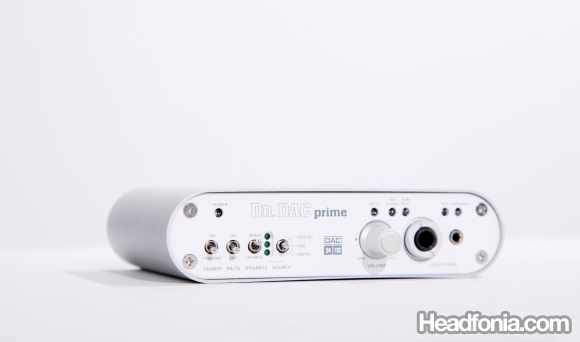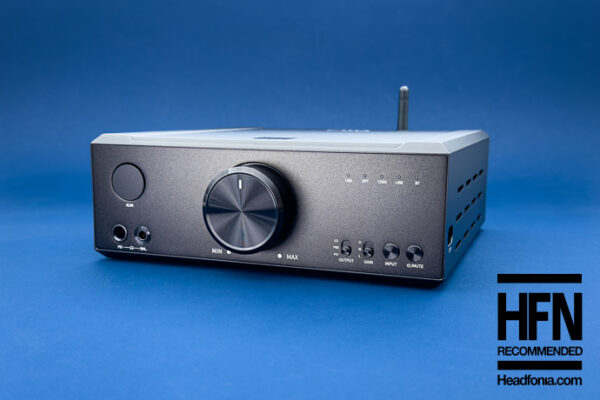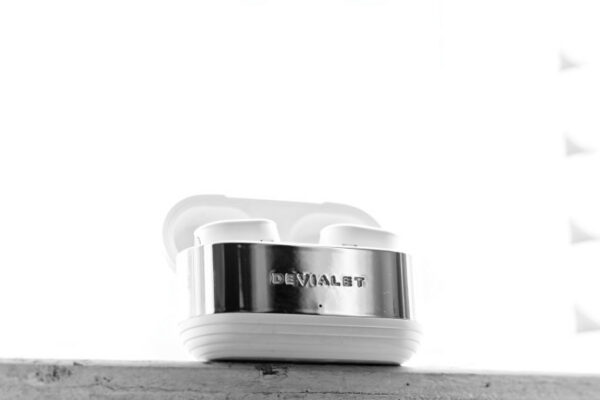When I first fired up my test unit, I was pretty underwhelmed with the sound that the Dr. DAC produced. Overall the sound was dull with a bright-ish treble that was downright offensive. Usually this symptom is a tell-tale sign that the unit needs some quality burn-in time. I proceeded to leave the Dr. DAC play music in loop continuously for about 50 hours before doing a formal impression. Well, let us just say the sound was drastically different from my initial impression after the rigorous burn-in session.
Before I proceed, please keep in mind that I am evaluating the Dr. DAC Prime primarily for its DAC function. I feed the Dr. DAC with music from my laptop computer using USB and output the signal via RCA to an external headphone amplifier. I will be evaluating the internal headphone section of the Dr. DAC separately later in this article.
The Dr. DAC overall struck me as a relatively neutral-sounding DAC which is tilted slightly to the bright side of things. This sound reminds me of the DIY AMB Gamma 1 that I used to have which had a similar sound signature but obviously, the Dr. DAC is a lot more detailed and refined compared to the Gamma 1. The treble presentation also has plenty of air in it with plenty of space between instruments. I like this coloration because it is a refreshing change from the other DACs in the Dr. DAC’s price range such as the HeadAmp Pico or Audio-gd Compass that otherwise have a warm-ish coloration.
I am pretty impressed with the magnificent amount of details that the Dr. DAC Prime resolves and it is without doubt that this ability to present details is the Dr. DAC’s strongest suit. I feel that the Dr. DAC is especially tuned to ace this aspect with its coloration: First of all, the Dr. DAC has a rather cold sound that accentuates the treble area which allows us to hear the details in the music better as there is no warmth that can otherwise “cloud” the sound and secondly, the Dr. DAC’s lean sound allows us to differentiate notes between notes and instruments between instruments as clear as day. These “tweaks” also give the Dr. DAC an agile sound that allows it to resolve micro details and transients very well. What is even more impressive that the Dr. DAC manages to resolve this information without sounding rough nor forced and truly, it is a smooth and joyful experience. If you are a detail-freak, I am sure that the Dr. DAC will be more than enough to satisfy your ears.
However, this crazy detail-resolving sound has a side effect which could be bad depending on your point of view and/or musical taste: I find that the Dr. DAC’s low-frequency response to be a bit underwhelming. Do not be mistaken though, the bass is tight and extension is very good but I find that it is a bit too taut as it has too little reverb for my taste. The bass is quite clinical in its presentation and I honestly would not mind trading the tightness a little bit for looseness which sounds very good with contemporary music for that extra bass punch. I am obviously nit-picking here as I suppose that others could live with the Dr. DAC’s bass as it is depending on their mileage. I imagine the tight bass will suit classical music very well.
Imaging-wise, I feel that the Dr. DAC is spot on though the individual differentiation of instruments is obviously not as precise as the higher-end DACs are capable of. Its sound presentation is a bit diffused with the instruments in the center stage taking the most spotlights while the ones in the back and around the central area sound less clear and focused. Once again I am probably nit-picking again here as I am comparing the Dr. DAC to gears that cost 3 to 4 times as much. Given the $499 MSRP the Dr. DAC presents a marvelous price-to-performance ratio.
I compared the sound with and without the 192 kHz upsampling and the differences are pretty subtle which you probably will not be able to pick apart during a casual listening session. With upsampling, the treble sounds a little bit more rounded and smoothed which I suppose could work well if you use a headphone with an aggressive treble.
Finally I would like to briefly touch on the integrated headphone amplifier. This section relies on amplification with 3 dual-channels National Semiconductor LME49860NA high-fidelity audio op-amps. They are also conveniently placed on DIP-8 sockets so you can switch them with other op-amps which present endless possibilities. Using the default configuration, the amplifier section sounds very linear with a touch of dryness that sounds curiously similar with the DAC section. Since the DAC already does a wonderful job in presenting a delectable sound, I suspect that ESI designs the amplifier to be as neutral as possible to show the DAC in its full glory. Power-wise, the amplifier section is not lacking at all as it is able to drive a K501 quite successfully and we know how hard it is to drive this beast. The bass reaches low and treble extension is very good as well. It is also worth mentioning that when I tested the amplifier with a Denon C751 IEM, there was no hiss observed.
I will finish this review by saying that the Dr. DAC Prime is such an impressive complete piece of gear. Other than the lack of marking in the potentiometer, the entire package is well thought-out with clear and logical labels, ease of use, relatively compact size and most important of all, the Dr. DAC looks classy and it will not look odd perching on your work table. This elegance is rivaled with the sound that it produces, whether you use the DAC to feed other amplifiers or its more-than-enough integrated headphone amplifier, the unit pulls through in all of our audio tests. The competition better watches out as ESI has put out a very serious and able product with the Dr. DAC Prime.
System for auditioning:
Headphones: Grado HF2, AKG K501, Denon C751
Transport: Dell XPS M1530
Amplifier: Grace M902








theo
this looks just like the dac 1 overture
id like to try the
http://www.jineung.co.kr/gnuboard4.utf8/bbs/board…
better cause it has the toslink input and still has coaxial output, if only the dr dac had the toslink input,, but it looks almost identical to the dac 1 overture
good review id been wanting to read a review on this dac for along time
Mike
Yes, the Dr.DAC Prime does seem almost "identical" tot he JAVS Overture. I'm guessing that Audiotrak OEMs for JAVS.
The Dr. DAC Prime does come with a Toslink input. If you look at the backpanel: http://www.headfonia.com/wp-content/uploads/2010/… you'll find inputs and outputs for Coaxial and Toslink. The Toslink input can be accessed by plugging one of the supplied mini-Toslink adapter. I'll take a picture of it later to illustrate it better.
Paul
Hello Mike,
Very nice review, i'm thinking of buying the dr.dac prime, but i have a few questions i wanted to ask you.
did you hear that at low ohms(around 50ohms) headphones the headphoneamp can cause a very silent buzz. Did you expirienced something like that.
And my second and most important question would be, could you name me an alternative DAC at around 300-370$, but it should be with an integrated headphoneamp.
oh and there is this dac which costs around 200 € its called the trends audio ud-10.1. it would be interesting how it compares to the audinst hud-mx1.
anyways i enjoy especially your dac reviews very much. keep it up.
greetings
paul
Mike
Hi Paul, sadly I no longer have the Dr. DAC Prime around, so I can't test for that buzz/noise. Now as for other recommendations, there are some other choices: http://www.headfonia.com/dr-dac2-dx/ http://www.headfonia.com/matrix-mini-i-balanced-d… http://www.headfonia.com/beresford-tc-7520-review…
The Dr. DAC2 DX is quite similar to the Prime in built and size. Its sound is mostly warmer than the Prime. The Matrix Mini-i has a slight midrange oriented sound. And you can check the Beresford review as well for the sound, I can't seem to sum it as well as the others.
I haven't had the chance to audition the trends, so I can't say much about that one. Sorry.
Paul
Thanks for your answer Mke , will look at the other reviews especially the beresford and matrix mini which i haven't read.
And i wanted to say that the comments section in your reviews is very informative so i read them all with great interest.
all the best
paul
Julian
Hey Paul,
I can verify that the Dr. DAC prime produces some kind of buzz when used with high sensitivity phones. I found a weird workaround for this problem: Feed a signal to the line in so loud that it clips. The buzz will be gone until you put the DAC into stand-by.
To get a loud enough signal, I simply connect the headphone out to the line in and then play RMAA's calibration signal with the volume knob turned up all the way.
Mike
Thanks for sharing, Julian.
Paul
hello Julian,
thanks for the tip. Will definetly try it when i get the Dac Prime.
Julian
Now I’ve got a question: Do you know the impedance of the headphone outputs? My triple.fi 10 sound a bit weird, which could be a sign of a too high output impedance.
Mike
Sorry Julian, I don't know what the impedance of the headphone out put is.
Julian
Do you know of another device with similar functions and quality as the prime, but with a 0 Ohm headphone output?
I did some measurements yesterday, and it seems the triple.fi have a treble roll-off of about 4dB compared to a 0 Ohm output.
Mike
Hi Julian, nothing that I know of at the moment.
Josh Sharlow
Wow, thats a very informative article for me. I like your wordpress blog. Maybe you should write more articles of these type. By the way, sorry for my bad english 😉 (=
Mike
Thanks, Josh. What do you mean by "these type"? 🙂